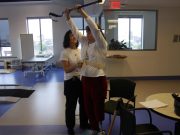Hypertension, often referred to as the “silent killer,” poses a significant health challenge, particularly for older adults. As we age, our bodies undergo numerous changes, making us more susceptible to high blood pressure and its complications. Managing hypertension effectively is crucial to maintaining a healthy, active lifestyle and preventing severe health issues such as heart disease and stroke. In this article, we aim to provide you with practical and compassionate guidance on how to navigate this condition. Whether you are an older adult managing your own health or a caregiver supporting a loved one, these tips are designed to empower you with the knowledge and tools needed to control hypertension and improve overall well-being. Let’s explore how small, mindful changes can make a significant difference in managing this condition, enhancing quality of life and fostering a sense of peace and confidence in your health journey.
Understanding the Unique Challenges of Hypertension in Older Adults
Managing hypertension in older adults presents a unique set of challenges, largely due to age-related physiological changes and the presence of comorbidities. It’s crucial to approach this condition with a holistic perspective, taking into account both physical and emotional aspects. Older adults often experience alterations in blood vessel elasticity and kidney function, which can affect how their body handles blood pressure. Understanding these changes is the first step in creating an effective management plan.
- Medication Management: It’s common for older adults to be on multiple medications, which can complicate hypertension treatment. Regular reviews of medication regimens are essential to avoid adverse interactions and ensure effectiveness.
- Lifestyle Adjustments: Encouraging regular, gentle exercise and a diet rich in fruits, vegetables, and low-fat dairy can significantly impact blood pressure levels. Consider activities like walking, swimming, or yoga, which are less strenuous and adaptable to varying mobility levels.
- Regular Monitoring: Frequent blood pressure checks can help detect fluctuations early. Home monitoring devices are a practical option, empowering individuals to take charge of their health.
| Challenge | Solution |
|---|---|
| Medication Side Effects | Consult with healthcare providers for alternatives |
| Dietary Restrictions | Incorporate heart-healthy recipes into meals |
| Mobility Issues | Explore adaptive exercise options |

Creating a Heart-Healthy Diet Plan Tailored for Seniors
Crafting a diet plan that supports cardiovascular health is crucial for seniors managing hypertension. As we age, our nutritional needs change, and it’s important to adapt our diets accordingly. Start by incorporating more fruits and vegetables, which are rich in vitamins, minerals, and fiber. These foods help reduce blood pressure and improve heart health. Consider adding leafy greens like spinach and kale, berries, and citrus fruits to your daily meals.
- Whole Grains: Swap out refined grains for whole grains such as brown rice, oats, and quinoa to help maintain steady blood sugar levels and reduce hypertension.
- Lean Proteins: Include sources like chicken, fish, beans, and legumes, which are beneficial for heart health.
- Healthy Fats: Opt for sources of unsaturated fats, such as avocados, nuts, seeds, and olive oil, to support cardiovascular health.
Monitoring sodium intake is also vital for controlling blood pressure. Aim to use herbs and spices to flavor foods instead of salt. Below is a simple table that outlines recommended daily intakes for key nutrients:
| Nutrient | Recommended Daily Intake |
|---|---|
| Sodium | Less than 1500 mg |
| Potassium | 3500-4700 mg |
| Fiber | 25-30 g |
Staying hydrated is equally important. Encourage the consumption of water throughout the day and limit sugary drinks. Remember, small changes can make a big difference in maintaining a heart-healthy lifestyle for seniors.

Incorporating Gentle Exercise Routines for Blood Pressure Control
Engaging in gentle exercise routines can be a transformative approach for managing blood pressure, especially for older adults. Regular physical activity helps in maintaining a healthy weight, enhancing circulation, and reducing stress levels, all of which contribute to lowering hypertension. It’s essential to choose exercises that are not too strenuous, yet effective. Here are some beneficial options:
- Walking: A simple, yet powerful way to improve heart health. Start with short distances and gradually increase your pace and duration.
- Yoga: Combines physical postures, breathing exercises, and meditation, which can help in reducing stress and promoting relaxation.
- Swimming: Offers a full-body workout without putting pressure on joints, making it ideal for those with arthritis or joint pain.
- Chair Exercises: Great for those with limited mobility. These exercises can include seated leg lifts, arm raises, and seated marches.
| Exercise Type | Duration | Frequency |
|---|---|---|
| Walking | 20-30 minutes | 5 times a week |
| Yoga | 30 minutes | 3 times a week |
| Swimming | 30 minutes | 3 times a week |
| Chair Exercises | 15-20 minutes | Daily |
Incorporating these exercises into your routine can foster a sense of well-being and help manage hypertension more effectively. Remember to consult with a healthcare provider before starting any new exercise program, ensuring that it aligns with your personal health needs and capabilities.

Monitoring and Managing Medication for Optimal Hypertension Management
Effectively monitoring and managing medication is crucial for older adults dealing with hypertension. As our loved ones age, their bodies may respond differently to medications, making it essential to regularly evaluate their treatment plans. Here are some strategies to ensure optimal management:
- Regular Check-ups: Schedule consistent appointments with healthcare providers to monitor blood pressure levels and assess medication effectiveness. These visits can help identify any necessary adjustments in dosage or medication types.
- Medication Adherence: Use tools like pill organizers or set reminders on smartphones to help maintain a consistent medication schedule. Ensuring medications are taken as prescribed can prevent complications and improve health outcomes.
- Side Effect Awareness: Stay informed about potential side effects of hypertension medications. Encourage open communication with healthcare providers to address any concerns or unusual symptoms promptly.
| Medication | Common Side Effects |
|---|---|
| ACE Inhibitors | Cough, dizziness |
| Beta Blockers | Fatigue, cold hands |
| Diuretics | Frequent urination, dehydration |
Engage in open discussions about lifestyle changes that can complement medication, such as diet modifications and increased physical activity. By taking a holistic approach to hypertension management, you can help older adults maintain their health and independence.








































